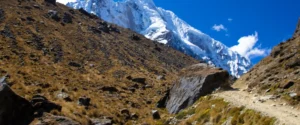Salkantay Trail: Complete Guide to the Best Alternative Trek to Machu Picchu
The Salkantay Trail is a stunning alternative trek to Machu Picchu, blending high Andean passes, turquoise lakes, cloud forest, and unforgettable views of the Inca citadel.

Why choose the Salkantay Trek?
Recognized among the best alternative treks to Machu Picchu, the Salkantay Trail delivers dramatic scenery from the snow-capped Mount Salkantay (6,271 m) to lush cloud forest valleys. You’ll hike original Andean paths, discover local communities, and enjoy remarkable contrasts in a single route.
Highlights include the crystal-clear Humantay Lake, the high-mountain crossing at Salkantay Pass (4,650 m), optional hot springs in Santa Teresa, and the grand finale at Machu Picchu. Compared to the Classic Inca Trail, permits are more flexible and availability is often better, making it ideal for travelers who want freedom without sacrificing the wow factor.
Salkantay Trail itinerary (5 days)
The 5-day version balances challenge, scenery, and time—perfect for most hikers:
- Day 1: Cusco → Mollepata → Humantay Lake → Soraypampa Camp
- Day 2: Soraypampa → Salkantay Pass (4,650 m) → Chaullay
- Day 3: Chaullay → La Playa → Santa Teresa (hot springs optional)
- Day 4: Santa Teresa → Hidroeléctrica → Aguas Calientes
- Day 5: Guided visit to Machu Picchu and return


Best time to hike
The best season for the Salkantay Trail is the dry season (April–October), with clearer skies and steadier trail conditions. Expect cold nights at high altitude. The rainy season (November–March) brings greener landscapes but muddier paths and possible showers—good gear is essential.
Difficulty & acclimatization
The Salkantay trek is moderate to challenging, with 6–8 hours of hiking on some days and significant altitude. Proper acclimatization in Cusco (at least 48 hours before the trek), hydration, and a steady pace are key to a safe and enjoyable experience.
Recommended gear includes broken-in trekking boots, warm layers, a waterproof jacket, sun protection, and walking poles. If you’re unsure about fitness or altitude, consult your guide in advance for pacing and mule support options where available.
Final thoughts: Is the Salkantay Trail worth it?
Absolutely—this is a complete Andean adventure. From glaciers and alpine lakes to cloud forest and the iconic Machu Picchu, the Salkantay Trek delivers variety, challenge, and world-class scenery without the permit bottlenecks of the Classic Inca Trail.
FAQs
Do I need a special permit for the Salkantay Trail?
How many days should I acclimatize in Cusco?
Is Humantay Lake included?
When is the best month to hike?


